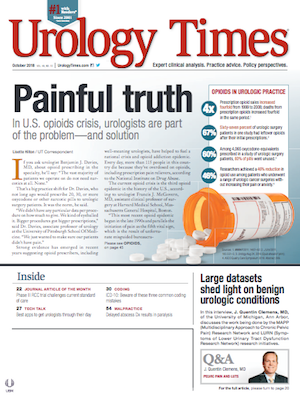Publication
Article
Urology Times Journal
What factors reduce the time you spend with patients?
Author(s):
“Our time with patients is very truncated. EMRs actually get in the way of good care. They consume huge amounts of time," says one urologist.
Urology Times reached out to three urologists (selected randomly) and asked them each the following question: What factors reduce the time you spend with patients?
“Our time with patients is very truncated. EMRs actually get in the way of good care. They consume huge amounts of time. They take away, directly, from being able to sit with the patient, listen to them, and provide all the needed care. We are not able to give quality time to patients.
During clinic, we actually took a close look at this and found that for every 15-minute clinic visit, we spend 9 minutes on the computer doing what’s required by regulation, billing, or administration to finish notes for that patient. So a 15-minute visit is consumed with 8 or 9 minutes on the computer, and patients end up getting the short end. To keep it from being even worse, we spend a couple of extra hours every night afterwards completing the charts.
Also see: What do you like/dislike about practicing in your state?
To try to keep patients from feeling shortchanged, I’ll sit and listen to them, and won’t start doing EMR for at least 4-5 minutes-just to hear them out. I’m consciously aware of the time crunch, because if I spend much more than that, I won’t have time to do what’s required on the EMR. If I had more time, I’d actually be able to listen to them-just be in the moment with them.”
Harold Frazier, II, MD
Washington
Next:"EMR is an obstacle to clear communication"“The EMR, the urologic work force shortage, and an aging population-we’re seeing more and more patients and try to provide access to them. Also, EMR is an obstacle to clear communication. Those are the changes that have reduced our time with patients.
Read: What traits are important to be a good urologist?
We’re big on patient education, making sure patients understand procedures, and informed consent. I felt I was getting hurried to provide that, so our group is making videos of the procedures we do-from vasectomy to radical prostatectomy to ESWL. They explain procedures, with animation, and even informed consent. A patient, either before I see them or right after, can watch these videos in our office. They go into more detail on the procedures they need [and explain] the risks and benefits.
Then I’ll go in and ask if they understand and if they have questions. So far, patients have really accepted them. They’re in laymen’s terms. They’re thorough and allow patients time to digest what they’ve heard, write down questions, and then follow up with the physician.
That gives me time to really communicate with patients. It’s always a challenge, but as far as trust and the rapport with patients-that hasn’t changed at all. The patient instruction video just enhanced that.
Our practice is also using more advanced practice providers-nurse practitioners and PAs. A lot of follow-up and educational visits are done with them. I explain to patients that we want to extend our access to them, to provide shorter wait times, more education, so we’re doing the team-based approach. Patients have really bought into what we’re doing. Patients like that at least two people know the details of their care. If the doctor’s not here, someone else knows about them. So far, it’s been a very positive experience for the patient.
Also see: Is it OK for physicians to hug their patients?
I like the team approach. Those are the two strategies Arkansas Urology has adopted.”
Timothy Langford, MD
Little Rock, AR
Next: "Mostly two things interfere with our patient time: the volume of patients and EMRs"“Mostly two things interfere with our patient time: the volume of patients and EMRs. We’re dealing with baby boomers and there are fewer urologists-more retiring with fewer coming out.
We’ve probably done two things to help us provide good patient care. We’ve embraced physician extenders to take some of the burden off, mainly to help patients who need to be seen on a more urgent basis. This allows more patients to get in. We’re still learning that process, but we’ve tried to embrace that.
Read: How do you manage noncompliant OAB patients?
The other adjustment we’ve made-mostly when we start getting behind-is to put EMR documentation to the side and finish our notes once we’ve finished with clinic-a lot of after-hours work.
It’s harder to do the EMR after hours. You definitely have to take good notes while you’re talking to patients because if you put it off more than a few hours, your notes won’t be as thorough or as accurate. Depending on the volume of patients you see, it’s hard to remember what you said to which patient. You really need to do them that night so you can keep them straight. They have to be done at some point, but you don’t want to sacrifice taking care of the patient.”
Brian Wade, MD
Birmingham, AL
























